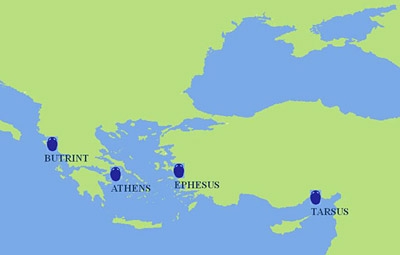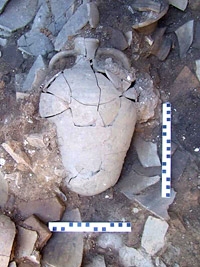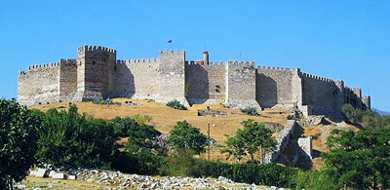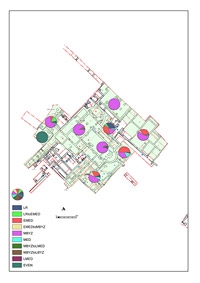Research project
Material Culture, Consumption and Social Change
New Approaches to Understanding the Eastern Mediterranean during Byzantine and Ottoman Times
- Duration
- 2010 - 2015
- Contact
- Joanita Vroom
- Funding
-
 VIDI - Nederlandse Organisatie voor Wetenschappelijk Onderzoek (NWO)
VIDI - Nederlandse Organisatie voor Wetenschappelijk Onderzoek (NWO)
- Partners
Nederlands Instituut Athene (NIA), Athens (GR)
American School of Classical Studies at Athens (ASCSA)
Österreichisches Archäologisches Institut (ÖAI), Vienna (AT)
Bogazici University, Istanbul (TR)
Butrint Foundation, London (UK)

Research questions
The VIDI research project aims to provide a new archaeological approach to the material culture of the Byzantine to Ottoman periods in the eastern Mediterranean and the Near East (from ca. the 7th to 20th centuries).
Whatever happened in the eastern Mediterranean during the ‘Dark Ages’ between the waning of Roman rule and the revival of the Byzantine Empire? How were these Byzantines wining and dining outside their capital Constantinople? And what did the Crusaders leave in Greek lands other than board games, fortifications and broken cooking pots?
In order to tackle these (and many other) questions related to social change, trade and consumption in the eastern Mediterranean and Near East the VIDI-Research Project 'Material Culture, Consumption and Social Change: New Approaches to Understanding the Eastern Mediterranean during Byzantine and Ottoman Times' focuses on key aspects of the material culture of the Byzantine and Ottoman Empires which have been neglected until now. The project also investigates relations and contacts between both empires with the Medieval West (Italy) and the Arab-Islamic East.

The research project sets out from the notion that the material culture of the Byzantine and Ottoman Empires offers crucial information for our understanding of these societies, which by their interaction with the West played such a vital role in the formation of Early Modern Europe. However, at this moment both Byzantine and Ottoman archaeology still require an up-to-date typo-chronological framework as well as a solid social and historical perspective.
The purpose of this VIDI-Project is to make a major contribution to Byzantine and Ottoman archaeology, to shed light on the dynamics of material culture and daily life in the Eastern Mediterranean from Late Antiquity to the Modern era (the period from the 7th to the 20th centuries) and to provide new insights which are unobtainable through written sources alone.
The historical information and archaeological material of each site pose different sets of questions. For example, in the case of Butrint and Tarsus that stood in the frontier of the Byzantine and Ottoman Empires, we explore interaction across frontiers as well as the political, economic, cultural and symbolic aspects of those frontiers. In the case of Athens, the numerous Medieval and Post-Medieval houses and graves excavated in the Athenian Agora, allow us to study everyday life, diet, economic activities and social processes through household and mortuary archaeology.
Research aims
The research project sets out from the notion that the material culture of the Byzantine and Ottoman Empires offers crucial information for our understanding of these societies, which by their interaction with the West played such a vital role in the formation of Early Modern Europe. However, at this moment both Byzantine and Ottoman archaeology still require an up-to-date typo-chronological framework as well as a solid social and historical perspective.
The purpose of this VIDI-Project is to make a major contribution to Byzantine and Ottoman archaeology, to shed light on the dynamics of material culture and daily life in the Eastern Mediterranean from Late Antiquity to the Modern era (the period from the 7th to the 20th centuries) and to provide new insights which are unobtainable through written sources alone.
Social relevance
The project aims to use the study of objects as a means to advance the understanding of historical developments and social change in a real long-term and diachronic ( longue durée) perspective. So, archaeology is used to obtain more knowledge on historical developments, on social changes as well as on cultural continuity and discontinuity in the period between the 7th and 20th centuries.
Scientific relevance
The project intends to develop a new approach to the material culture of the Byzantine and Ottoman Empires. These empires succeeded each other, were closely interwoven, and played throughout the centuries an important role as the ‘East’ in relation to Western Europe.
The focus of the project will be on the dynamics of material culture in Byzantine and Ottoman societies, especially on the relation between changing shapes and functions of artefacts in relation to wider socio-economic developments. Thus, besides to advance the diagnosis and dating of artefacts (especially ceramics), the project aims to contribute to the understanding of material culture in broader contexts. Emphasis is placed on the complex relations between changing pottery production and trade patterns, between changing cooking and dining habits and social identities (e.g. the emergence of outsiders, such as Western Crusaders in the Byzantine world; or new elites, such as bureaucrats at the Ottoman Court).
Material & Methods

The project includes inter-regional comparisons. Data from four major urban centres as well as from various rural regions in the Byzantine and Ottoman Empires will be studied in a comparative perspective. The urban centers are Butrint in Albania, Athens in Greece, Ephesus in western Turkey and Tarsus in eastern Turkey; the archaeological data from these cities will be compared with the data from rural sites and areas in the countryside.
The four sites studied in this project (Butrint, Athens, Ephesus and Tarsus) have all had a long period of occupation, spanning from prehistoric to modern times. Modification of the natural and built environment will be studied to trace how pre-existing environments were used in later periods and how cultural landscapes were perceived and created in different times.

The study of the data is multidisciplinary. Archaeological artefacts (ceramics, glass and cutlery) as well as written texts and pictorial evidence will be used as sources of information. Earlier research by the project leader suggests that this line of research has a very high potential of providing new insights on long-term regional and cross-cultural developments in material culture in the widest sense during Byzantine and Ottoman times.
Methodology
The project studies material from four major urban centres, Butrint in Albania, Athens in Greece, Ephesus in western Turkey and Tarsus in eastern Turkey. Initially, the material from each individual site will be studied in the political and socio-economic context of its region. In a later stage, this research will include inter-regional comparisons among the four sites, and a study of the dynamics of the four sites with other major administrative and economic centres of the Empires (such as Constantinople/Istanbul).
The project combines the study of archaeological artefacts with textual sources, art, and ethnography as parts of an interdisciplinary analysis of long-term regional and cross-cultural developments in the Mediterranean world during the Medieval and Post-Medieval periods.
The research is grounded on new conceptual frameworks suitable to interpret social and economic strategies beyond the usual generic explanations of conquest, "barbarian" invasions and natural catastrophes.
A new database
To record information in a systematic and coherent way, a new database has been designed, taking into consideration the specific needs of this project, the nature of the material recorded and the different levels of knowledge of the project members. The database is currently used as a recording and storing tool, as well as a powerful quantification and analytical tool that enable us to explore patterns of artifact concentrations and distributions quickly and efficiently and to make sense out of thousands of sherds of different, fabric, shape, decoration, function, and provenance that span thirteen centuries.
Geographic Information Systems (GIS)

The project's database is also linked to GIS to map and further explore patterns of artifact concentration. The distribution maps we are creating can answer far more questions than simply where things were found. For example, we study the distribution of artifacts that share same characteristics to highlight various possible activities and their location in the urban sites under study. We are also examining the spatial relation among artifact assemblages and architectural remains to better understand processes of use, abandonment, reuse of space, and secondary depositions of artifacts. Furthermore, we investigate the relations of the four urban centers with their hinterland and neighboring regions by recording and mapping the type, frequency and location of artifacts that are associated with the production and consumption/use of both local and imported goods.
Results & conclusions
See under research project pages ‘Butrint’, ‘Athens’, ‘Ephesus’, ‘Tarsus’.
Follow-up
Results from Butrint, Athens and Ephesus have already been presented at specialised international conferences and will be published as peer-reviewed journal articles and as contributions to collective edited volumes.
The medieval ceramics of the Gozlukule Tarsus excavations will be published in articles and in Yasemin Bağcı’s PhD thesis “Revisiting the Medieval Ceramics of the 1935-1948 Gözlükule excavation in Tarsus, South Turkey.” in 2016.
Relations with other projects
POMEDOR: People, pottery and food in the medieval Eastern Mediterranean.
